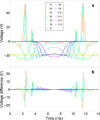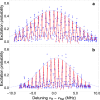Speeding up adiabatic ion transport in macroscopic multi-Penning-trap stacks for high-precision experiments
- PMID: 40125539
- PMCID: PMC11922740
- DOI: 10.1038/s42005-025-02031-2
Speeding up adiabatic ion transport in macroscopic multi-Penning-trap stacks for high-precision experiments
Abstract
Multi-Penning traps are an excellent tool for high-precision tests of fundamental physics in a variety of applications, ranging from atomic mass measurements to symmetry tests. In such experiments, single ions are transferred between distinct trap regions as part of the experimental sequence, resulting in measurement dead time and heating of the ion motions. Here, we report a procedure to reduce the duration of adiabatic single-ion transport in macroscopic multi-Penning-trap stacks by using ion-transport waveforms and electronic filter predistortion. For this purpose, transport adiabaticity of a single laser-cooled 9Be+is analyzed via Doppler-broadened sideband spectra obtained by stimulated Raman spectroscopy, yielding an average heating per transport of 2.6 ± 4.0 quanta for transport times between 7 and 15 ms. Applying these techniques to current multi-Penning trap experiments could reduce ion transport times by up to three orders of magnitude. Furthermore, these results are a key requisite for implementing quantum logic spectroscopy in Penning trap experiments.
Keywords: Experimental nuclear physics; Quantum metrology; Raman spectroscopy.
© The Author(s) 2025.
Conflict of interest statement
Competing interestsThe authors declare no competing interests.
Figures




References
-
- Schüssler, R. X. et al. Detection of metastable electronic states by Penning trap mass spectrometry. Nature581, 42–46 (2020). - PubMed
-
- Filianin, P. et al. Direct Q -Value Determination of the ß Decay of Re 187. Phys. Rev. Lett.127, 072502 (2021). - PubMed
-
- Heiße, F. et al. High-precision measurement of the Proton’s Atomic Mass. Phys. Rev. Lett.119, 033001 (2017). - PubMed
-
- Sturm, S. et al. High-precision measurement of the atomic mass of the electron. Nature506, 467–470 (2014). - PubMed
-
- Sasidharan, S. et al. Penning-trap mass measurement of Helium-4. Phys. Rev. Lett.131, 093201 (2023). - PubMed
LinkOut - more resources
Full Text Sources
